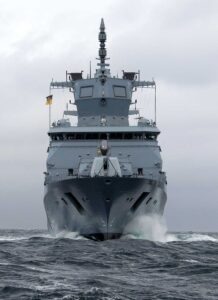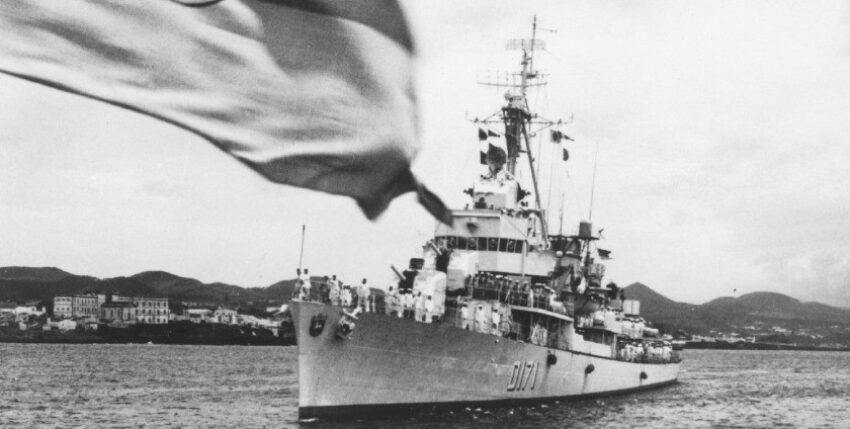Today, as a hundred years ago, it is crucial that the naval armament is appropriate to the threat. But this is precisely what the German navy lacked.
"If you want peace, prepare for war". When, if ever, in 175 years of naval history was the fleet equipped to meet the threat, and are we today?
The war picture is the basic idea of the nature of a possible future war, its manifestations, means, intensity and the effects on military warfare. It is the foil for a general strategy with strategic objectives and the resulting consequences for the orientation of military means at operational and tactical level. If naval warfare assets effectively support an overall strategy, the fleet is positioned to meet the threat. The strategic considerations of the war picture are made on the basis of the goal-means-approach.
After the end of the Franco-Prussian War and the annexation of Alsace-Lorraine, there was irreconcilable enmity with France. This conflict defined the image of war and thus Otto von Bismarck's alliance policy. Bismarck's foreign policy was geared towards avoiding a two-front war with France and Russia as well as opposition to Great Britain at all costs. In contrast to Bismarck, his successor, Imperial Chancellor Leo von Caprivi, sought a closer alliance with Austria-Hungary, so that the danger of a war on two fronts loomed for the German Empire.

Under the aegis of Generals von Stosch and von Caprivi, the navy was assigned the task of defensive coastal defence with offensive elements. Navalism under Kaiser Wilhelm II and the naval laws of 1898 and 1900 marked the beginning of maritime armament for a great power policy. Tirpitz's experiences in the fleet's autumn manoeuvres formed the basis of the First Fleet Act. In their basic conception, they corresponded to Alfred Thayer Mahan's ideas on naval supremacy: to strive for an offensive strategy characterised by naval battle.
The strategic goal was to gain naval power to secure world power status and a "place in the sun". The way was an offensive squadron war, the means a battle fleet consisting of ships of the line and cruisers. Tirpitz's underlying theory of risk was based on the assumption that two thirds of England's fleet in the North Sea would be available. Tirpitz characterised the period of time in which armaments could be deployed as a danger zone. Within this zone, a surprise, pre-emptive attack by the Royal Navy could not be ruled out.
However, the Royal Navy changed its defence strategy in the North Sea as early as 1911. Instead of a close blockade, the long-distance and economic blockade resulted in a passive role for the High Seas Fleet without the hoped-for decisive war effort - a fleet in being.
Criticism within the ranks of the navy, such as that of naval officer Curt von Maltzahn, could not prevail against the path of squadron warfare favoured by Tirpitz.
Although the successful British distant blockade was not decisive for the war, it caused a considerable economic weakening and impairment of the Empire's war economy through the control of sea lines of communication.
This meant that the Imperial Navy was hardly up to date with the war picture at the beginning of the First World War, although the armaments were based on an ends-means approach. The unchanged armaments after the change in naval strategy from 1912 proved to be a confirmation bias of the Empire: the perspective and the path taken did not change. The new situation was faded out and ignored, the Tirpitz risk fleet proved to be an unsuitable means of naval warfare.
Reichsmarine and Kriegsmarine
The navy feared for its existence and legitimacy in the period between the world wars due to its perceived inadequate deployment in the First World War and the sailors' revolt, which was labelled a "disgrace". The Treaty of Versailles limited the Reichsmarine to a coastal navy with an upper personnel limit of 15,000 men.
From 1922 onwards, the aim of maritime armaments was to ensure defence capabilities in a two-front war against Poland and its ally France. The Baltic Sea region was to form the centre of gravity. The strategy was defensive, combined with tactical-offensive elements. Priority was given to the protection of overseas trade routes, which was to be postponed in the event of an immediate threat to the coasts. As a result of this determination, other means of naval warfare moved into the strategic planning than those that would have been required exclusively for a coastal navy.
The question of whether Germany needed large warships was answered in the affirmative by Admiral Erich Raeder as head of the naval command, referring to experiences from the First World War, the trade war in the offensive, led by cruisers and the defensive protection of its own sea lines of defence.
An open confrontation with England had to be avoided at all costs in this scenario. Compared to the First World War, Raeder developed the naval warfare and thus the way to achieve the objective decisively further. Oceanic, long-range cruiser warfare was to relieve the pressure on the home front through the diversionary effect. "Faster than the strong, stronger than the fast", the armoured ship A as a naval warfare asset corresponded to these considerations. Adolf Hitler's totalitarian goals, such as the expansion of living space in the east, made a revision of the war picture unavoidable.
With the outbreak of war in 1939, it became clear that the Z-Plan, which had been pushed through shortly beforehand, and its planning horizon until 1946 could not lead to a successful confrontation with England. The surface forces were hopelessly inferior.

Before the seizure of power, post-war turmoil and the requirements of the Treaty of Versailles made it impossible to implement a structured target-means approach for at least a decade. Operational planning in the 1930s could no longer be successfully realised due to the drastic expansion of strategic goals according to this approach. As in the First World War, the war was once again forced into a protracted economic war instead of the hoped-for short, victorious war.
The navy, far below a critical size, could not exert a sufficient effect as a means. For a potentially more successful cruiser war, there was a lack of units and distribution of naval warfare resources. If the Imperial Fleet lacked sufficient and suitable bases, Hitler's navy lacked a fleet.
German Navy during the Cold War
The end of the Second World War led almost seamlessly into the Cold War phase with two opposing war images: on the one side the USA, initially with a monopoly on nuclear weapons, and as a potential opponent the USSR with a large conventional strike force. The rearmament of the Federal Republic of Germany and its accession to NATO in 1955 placed the country, which had once aspired to be a world power, in a bipolar world order.
For the first time, the strategic objective and war picture were defined externally in coordination with the victorious powers and allies. This was intended to prevent a Russian naval breakthrough out of the Baltic Sea, operating against supply lines to Europe in the Atlantic.
The way forward was to utilise the military potential of the German Navy in accordance with the minimum strength specified by NATO for equipment and training and the necessary naval warfare resources within the framework of a planning horizon up to 1963.
Although an ends-means approach was consistently pursued, the level of naval assets in the 1960s remained too low compared to the Soviet bloc to ensure the successful defence of the Baltic Sea without NATO support. From 1960 onwards, three decades of consistent rearmament in accordance with NATO specifications followed in order to make the navy more future-proof and modernise its quality by the 1980s. The navy extended the area of potentially successful defence into the central Baltic Sea.
Thus, for the first time in German naval history, the so-called danger zone was left behind; the navy was at the height of the war picture. It is evident that the target-route-means approach must be pursued long and consistently enough in order to have sufficient naval assets at the end. As a result, the balanced force potential and offensive capability prevented a war between the two blocs.
The German Navy
With the end of the Cold War, a new orientation began: on the one hand, the search for new goals and, on the other, international crisis management (ICM) with Operation Enduring Freedom after 11 September 2001. The deployment of units to the Indian Ocean and buzzwords such as constabulatory missions and responsibility to protect describe a new military world with new derivations of paths. These concepts are being consistently implemented in the Alliance's armed forces in new ways and means approaches. The Class 125 frigates represent a means of naval warfare in line with these considerations - a compromise between stability, self-defence and ICM capability. The culmination points between 2014 and 2015 evoke two strategic challenges: the annexation of Crimea in violation of international law and the refugee crisis - a dilemma for political targeting.
The strategic orientation from the 2016 White Paper, the Bundeswehr Concept, the Bundeswehr Capability Profile and the 2011 Defence Policy Guidelines illustrate how outdated and out of date these objectives are compared to nations such as the USA. There is a lack of concrete and cascading targets.
Key factors
The announced turnaround also lacks a concretely defined image of war and clear derivation in basic strategic documents. There is a lack of a national security strategy as well as a cyclical and open-ended adaptation option. This is precisely what appears to be essential in times of changing strategic challenges. The lack of a national security strategy can no longer be described as "charming" and "flexible" if Germany aspires to a leadership role. As part of the "cornerstone of conventional defence", IPD and international crisis management are difficult to manage simultaneously alongside the actual focus on national and alliance defence.

As was the case for Tirpitz, the danger zone is also an important factor for us. Recognising and controlling the timeline in which armaments can be deployed is crucial in order to be and remain in line with the war picture. The time before the fulfilment of the NATO New Force Model and the resulting target picture of the Navy 2035+ can also be assessed as a danger zone. We can only achieve the required "cold start capability" if the necessary resources are available and ready for combat at the start of the conflict. Authenticity and commitment at European level will only become visible if we achieve the goals without pushing a target picture further into the future. The annexation of Crimea and the war of aggression against Ukraine have shown that we must be willing and able to arm ourselves for the future and learn from history. This requires a politically sustainable will, appropriate funding and a critical evaluation of all our process structures.
Certainly, the fleet and naval warfare resources were never available in sufficient and desired strength or form. A danger zone has always existed. We are required to plan and equip strategically and purposefully. We must not succumb to confirmation bias by confirming to ourselves that our naval warfare assets are outstandingly suitable. "Does Germany need large warships?" - Yes, but in times of hybrid maritime warfare they must make a significant contribution that justifies their size and cost in the system - capacity and capability.
Joachim Mrnka










